Issue 08. 11 June 2012 - UWA Staff - The University of Western ...
Issue 08. 11 June 2012 - UWA Staff - The University of Western ...
Issue 08. 11 June 2012 - UWA Staff - The University of Western ...
Create successful ePaper yourself
Turn your PDF publications into a flip-book with our unique Google optimized e-Paper software.
Achieving universal excellence from page 1<br />
“<strong>The</strong> low and middle frequency components to be deployed at<br />
the Murchison Radioastronomy Observatory (MRO) in the first<br />
phase <strong>of</strong> the SKA will concentrate on the survey science<br />
aspects <strong>of</strong> the SKA mission,” he said.<br />
“<strong>The</strong> MRO is a fantastic site for low and middle frequencies<br />
due to the lack <strong>of</strong> FM radio and mobile phone interference.<br />
<strong>The</strong> Republic <strong>of</strong> South Africa site will focus on the high<br />
frequency mission <strong>of</strong> the SKA, which will benefit from the<br />
attributes <strong>of</strong> that site.<br />
“ICRAR is at the right place at the right time to benefit from<br />
this announcement. We have exactly the skills and capacities<br />
to begin contribution to both the SKA technologies to be<br />
placed in WA through our involvement in information and<br />
communication technology, international low frequency<br />
aperture array technology research and the Murchison<br />
Widefield Array project.”<br />
As the final decision drew closer, ICRAR staff and supporters<br />
were gathered at their <strong>UWA</strong> base on the night <strong>of</strong> Friday<br />
25 May. With them were some <strong>of</strong> the ICRAR Board members,<br />
Dr Bernard Bowen, Pr<strong>of</strong>essor Alistar Robertson, Phillip Jenkins<br />
and Graham McHarrie, as well as a team from the State<br />
Department <strong>of</strong> Commerce, including the Minister for Science,<br />
John Day.<br />
“We heard the announcement from the Netherlands about<br />
8pm,” said Dr Renu Sharma, general manager <strong>of</strong> ICRAR.<br />
“Peter (Quinn) opened a bottle <strong>of</strong> champagne and we all<br />
celebrated. It was very exciting, after such a lot <strong>of</strong> hard work<br />
by everybody.”<br />
M42 <strong>The</strong> Orion Nebula (Photo: NASA, ESA, M Roberto, Space Telescope Science Institute/ESA)<br />
Pr<strong>of</strong>essor Quinn said the dual site decision had been taken<br />
after the SKA Organisation looked at the best options and<br />
ensured that a dual site was scientifically possible.<br />
“One <strong>of</strong> the big benefits is that both sites will be able to use and<br />
build on our existing infrastructure,” he said. “Big investments<br />
have been made in the lead-up to the SKA site decision.<br />
Australia has invested more than $400 million already.”<br />
<strong>The</strong> new plan to share the SKA will see Australia’s Mid-West<br />
hosting two key components <strong>of</strong> the telescope – a group <strong>of</strong><br />
dishes equipped with Australian-designed multi-pixel radio<br />
cameras and the ‘Aperture Array’ portion, made up <strong>of</strong><br />
innovative, non-moving antennae designed to collect lower<br />
frequency radio waves from the whole sky.<br />
“This part <strong>of</strong> the SKA will be optimised to survey large portions<br />
<strong>of</strong> the sky quickly, a particular strength <strong>of</strong> Australian astronomy,”<br />
said <strong>UWA</strong> Pr<strong>of</strong>essor Lister Staveley-Smith, Deputy Director <strong>of</strong><br />
ICRAR.<br />
South Africa will host a complementary group <strong>of</strong> dish-shaped<br />
telescopes designed to observe smaller sections <strong>of</strong> the sky in<br />
more detail, following up on regions <strong>of</strong> interest discovered using<br />
the survey portion.<br />
“This model for splitting the SKA closely follows the workings <strong>of</strong><br />
other observatories around the world; <strong>of</strong>ten separate<br />
instruments will survey the sky and inform where another<br />
telescope should look closer,” Pr<strong>of</strong>essor Quinn said.<br />
“<strong>The</strong>se global science endeavours will continue to benefit<br />
<strong>Western</strong> Australia and the international scientific community<br />
long into the future. <strong>The</strong> effort Australia and WA has made in<br />
infrastructure, legislation and policies will make the Murchison<br />
Radio-astronomy Observatory a significant centre for global<br />
science for decades to come,” he said.<br />
“As an International centre, we’re eager to continue our work<br />
with colleagues in Africa and the rest <strong>of</strong> the world to build the<br />
SKA and use it to explore the Universe in 10,000 times more<br />
detail than ever before.”<br />
<strong>The</strong> SKA is a project for future generations. Completion is<br />
planned for 2024.<br />
Photo © Swinburne Astronomy Productions, design data provided by CSIRO<br />
2 | <strong>UWA</strong> NEWS <strong>11</strong> <strong>June</strong> <strong>2012</strong> the <strong>University</strong> <strong>of</strong> <strong>Western</strong> Australia


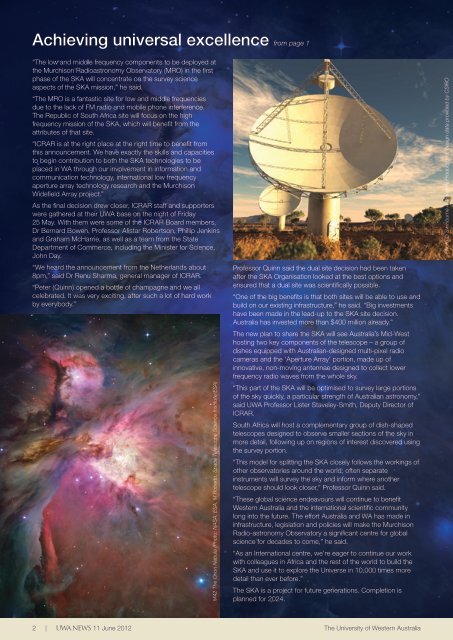
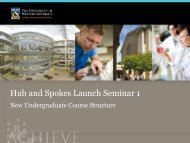

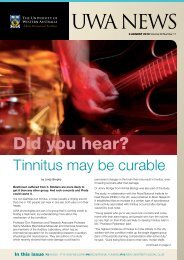






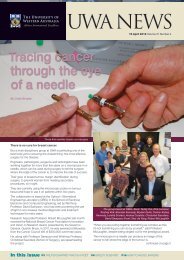
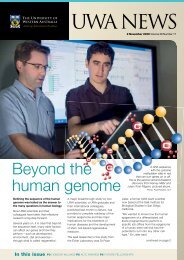
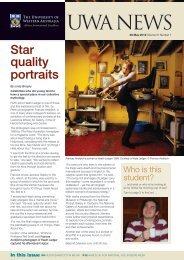

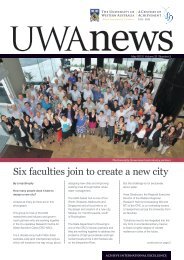
![Issue 13. 6 September 2010.pdf [PDF File, 1.7 MB] - UWA Staff - The ...](https://img.yumpu.com/26619782/1/184x260/issue-13-6-september-2010pdf-pdf-file-17-mb-uwa-staff-the-.jpg?quality=85)